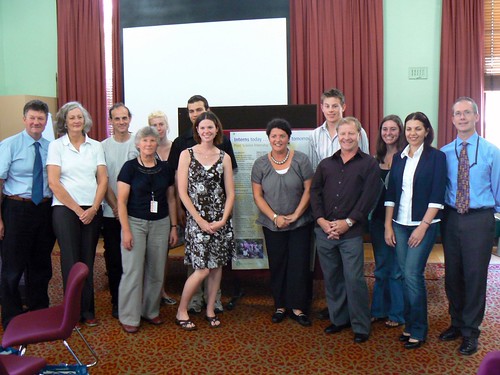On far right: Dr Tim Entwistle, Executive Director of the Botanic Gardens.
Sixth from right: Caro Webster, President of the Friends of the Gardens.
Sixth from right: Caro Webster, President of the Friends of the Gardens.
The Media Release from the Gardens:
The science of plants opens new doors
A group of 10 plant scientists of the future have been trained by Australia’s best, while at the same time helping to collect, study and record plant species for the National Herbarium of NSW.
Botanic Gardens Trust Executive Director Dr Tim Entwisle will present completion certificates to students of its 2008 Plant Science Internship Program today and thank them for their contribution.
“This work experience was very hands-on; the students contributed a great deal to our scientific study of plant species. Their efforts included helping us to re-organise the Herbarium in accordance with the latest DNA studies,” Dr Entwisle said.
“DNA sequencing has opened up amazing opportunites for the Botanic Gardens. While students identified plants using books and the internet, their efforts will help us create a DNA barcoding system that will contribute to the goal of eventually identifying every plant on the planet.
“Plant DNA barcoding will one day be a simple ‘black box’ method for distinguishing one species from another. For example, it will be used to quickly inventory biodiversity in a protected area or to monitor shipments of plants for illegal trading and endangered species,” he said.
“To bring this project to fruition, we need high quality science to first describe and classify the things we want to identify. There are still lots of flowering plants, and probably many thousands of algae and fungi yet to be discovered, let alone described and classified,” he said. “There is work to be done and these new scientists are already making a major contribution.”
The NSW-based science students who currently study related topics at universities and TAFE’s, gave up their summer holiday period to take part in the seven week 2008 Plant Science Internship program which is largely funded by the Friends of the Gardens for the Botanic Gardens Trust.
Coordinator of the Intern program, Bob Makinson said the students were shown a wide range of plant communities on the Central Coast.
“During the program, we discussed the management implications of the areas we visited, with guest speakers from the National Parks and Wildlife Division of the Department of Environment and Climate Change,” Mr Makinson said.
“The interns also contributed greatly to maintaining the Herbarium’s collections. The purpose of the NSW Herbarium is to know and record everything about the Flora of NSW and nationally. Plants are also collected from South West Pacific and South East Asia.
“In the last four weeks of our 2008 Intern program, the really important work began. This is when the students were allotted tasks and work with science staff on research projects, he said.
As a going away present, one of the Amorphophallus titanum (Titan Arum or Corpse plant) growing in the Garden's Tropical Centre decided to flower for them, a rare but spectacular event:
The reason the plant is draped in black fabric is that the Tropical Centre staff are taking time-lapse photos of it as it opens. Once the flower develops, it grows remarkably quickly--around 10 centimetres a day. I took this photo on Friday, but by now it will have opened, revealing exactly why it's called a corpse plant. It emits a foul odour to attract pollinators that consume dead flesh.
The dimensions of a mature Amorphophallus titanum, from the Gardens' Fact Sheet.
spadix — 2 to 2.9 metres (7 to 12 feet)
leaf height — 6 metres (20 feet)
leaf width — 4.5 metres (15 feet)
tuber (corm) — 100 kilograms (220 pounds)
Boggling, all in all!
The dimensions of a mature Amorphophallus titanum, from the Gardens' Fact Sheet.
spadix — 2 to 2.9 metres (7 to 12 feet)
leaf height — 6 metres (20 feet)
leaf width — 4.5 metres (15 feet)
tuber (corm) — 100 kilograms (220 pounds)
Boggling, all in all!







